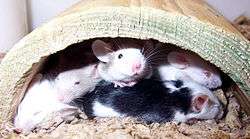Pocket pet

Pocket pet is a term used to refer to any small mammal commonly kept as a household pet.
The most common pocket pets include rodents such as: hamsters, gerbils, fancy mice,[1] fancy rats[1] and guinea pigs. It also includes pets such as sugar gliders,[2] flying squirrels, and hedgehogs, which have been bred as domestic housepets in the U.S. for the last 15 years.
The domestication of small mammals is a relatively recent development, arising only after large-scale industrialization. Historically, when western society was more agrarian than it is today, rodents as a whole were seen as a nuisance, as they were vessels for disease and threats to crops. Animals that hunted these pests, such as terriers and cats, were prized.
Guinea pigs have perhaps the longest tradition of pethood among rodents. While they served as a foodstuff for the native Inca, they were imported to Europe as early as the mid-16th century, shortly after Spain conquered Peru. As an oddity from the New World, they were afforded a special status, and seen as pets, rather than pests. While their popularity was initially limited to the wealthy, their prodigious reproductive habits ensured that they spread throughout the middle classes shortly after their introduction, with guinea pig burial places (not scattered bones, as would be found with an eaten animal) found in archaeological digs in medieval middle-class suburbs.[3]
Fancy mice were popular pets in Japan during the 18th century, due in large part to the abundance of color mutations in wild mice. In 1787, a book on this hobby, called The Breeding of Curious Varieties of the Mouse was published by Chobei Zenya, a Kyoto money exchanger. Over time, the tradition spread from Japan to Europe, and 1895 saw the establishment of the National Mouse Club in England.[4]
Fancy rats first became popular pets in Victorian England, being selectively bred for unusual colouration or temperament.[5]
Hamsters first gained popularity as pets in the 1930s, with virtually all modern Syrian hamsters tracing their lineage back to a single litter of hamsters taken to Palestine for scientific research in 1930. Hamsters were first brought to the United States in 1938.[6]
It wasn't until 1964 that gerbils became a standard part of the pet industry.
References
- 1 2 A Man for All Species: The Remarkable Adventures of an Animal Lover and ... - Marc Morrone, Nancy Ellis-Bell - Google Books
- ↑ Complete Care Guide for Your Sugar Glider: The Perfect "pocket" Pet - Debbie Dillon - Google Books
- ↑ http://www.livescience.com/18286-guinea-pigs-europe-arrival.html
- ↑ http://www.afrma.org/historymse.htm
- ↑ http://www.afrma.org/historyrat.htm
- ↑ http://www.veterinarypartner.com/Content.plx?A=679
Further reading
- Pills for Pets: The A to Z Guide to Drugs and Medications for Your Animal ... - Debra Eldredge - Google Books
- Veterinary Assisting: Fundamentals & Applications - Beth Vanhorn, Robert W. Clark - Google Books
- Lobprise, Heidi. "Dentistry Quarterly: Challenges in Pocket Pet Dentisty". Veterinary Practice News. Retrieved 2013-05-04.
- Pocket Pets
- What are pocket pets? | PETA.org
- Christopher Carter Pocket Pets
- Pocket Pet Diseases and Resources « CFSPH
External links
- Pocket Pet Care. American Animal Hospital Association.